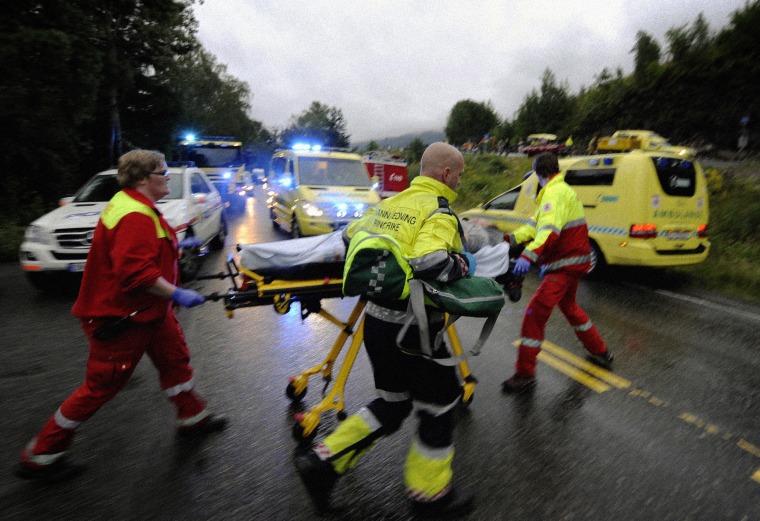Ten years ago Thursday, a white supremacist terrorist disguised himself as a police officer and brutally murdered 77 people — most of whom were children and young adults — in Norway. But it has been only a year since governments have turned their focus to white supremacy as a rising cause of violence.
It has been only a year since governments have turned their focus to white supremacy as a rising cause of violence.
The attacks marked the start of an era in far-right extremism that would be all but ignored by U.S. and global counterterrorism authorities for years to come. We are reaping the consequences of that inattention now.
The facts of the attacks on July 22, 2011, are unambiguous and horrifying. After detonating a vehicle bomb that killed eight people at a government building in central Oslo, a 32-year-old Norwegian man traveled to nearby Utøya island, where an annual youth summer camp held by the leading political party was underway. For well over an hour, he systematically gunned down dozens of children and young adults across the island, killing 69 people and wounding scores more before he was apprehended.
The terrorist's rationale for the attacks — laid out in a 1,500-page manifesto — was rooted in extreme anti-Islam and anti-immigrant beliefs. He saw Norwegian political leaders as blinded to an existential threat posed by multiculturalism, which he argued was leading to the deliberate and orchestrated Islamization of Europe by Muslim immigrants.
Although the attack was focused on Norway, it was strongly influenced by the American and global Islamophobia industry, as his scores of citations of anti-Islam activists illustrate.
The world was shocked by the attacks. But in the throes of the post-9/11 global focus on Islamist terrorism, security and intelligence officials treated the Oslo attacks as a fringe incident, rather than understanding it as part of a broad and growing trend of rising white supremacist extremism. This pattern would hold for years to follow.
The U.S. government even rebuffed efforts by its own intelligence and security officials to enhance its agencies' focus on white supremacist extremism. In the end, it would take eight years following the attacks in Norway for American and global terrorism experts and policymakers to start to take the threat of white supremacist extremism more seriously.
Although the attack was focused on Norway, it was strongly influenced by the American and global Islamophobia industry.
That delay allowed white supremacist extremism to fester. The Oslo attacks directly inspired terrorist and mass shooter attacks and plots in at least six countries — including the 2019 livestreamed murders of 51 Muslim worshippers in New Zealand.
The indirect effect might have been even greater than those directly inspired attacks. immediately after the attacks, the Norwegian terrorist became a hero to the global white supremacist movement, idealized as a martyr in the vast ecosystem of online white supremacist youth culture. On toxic online forums and imageboard sites, he is still listed at the top of scoreboards that celebrate mass shooters' "kill counts." Like other white supremacist terrorists, he is referred to in these spaces as a "saint," while those who seek to emulate him are "disciples."
In this way, the vast and toxic online ecosystem that was still emerging as that Norwegian man was planning his attacks has helped not only extend and amplify the direct harm he caused but also further fomented the supremacist logic that underpinned those attacks. The idea of an existential threat to Western, Christian civilization so clearly articulated in the terrorist's manifesto spread into memes and satirical videos and eventually morphed into a broader spectrum of supremacist thinking that dehumanizes groups deemed "inferior" and mobilizes violent extremism against them.
This includes the male supremacism evidenced in mass attacks against women by "incels" (involuntary celibates) and the self-described "Western chauvinism" of the Proud Boys. Rapid growth in QAnon conspiracy theories was driven in part by their appeal to Christian nationalists.
The world had experienced white supremacist terrorism long before the attacks in Norway, of course. But there was a notable shift after Oslo — both in directly inspired attacks and in those motivated by rising white supremacist extremism more broadly. Attacks at a Wisconsin Sikh temple, a Black South Carolina church and a Pittsburgh synagogue were just a few of hundreds of global far-right terrorist attacks over the past decade, with over 35 far-right terrorist attacks taking place each year in North America, Western Europe or Oceania for the past five years.
Governments around the globe began to address the changing threat landscape in earnest only last year, when the Department of Homeland Security officially acknowledged in the fall that white supremacist extremism is the most persistent and lethal threat facing the nation.
Shortly after that, the governments of Germany and New Zealand announced sweeping legislation to tackle the threat. Last month, the Biden administration released the first National Strategy for Countering Domestic Terrorism.
The question now is whether these efforts are too little, too late to put the genie back in the bottle. To ensure that they are not, we need both a deeper commitment to preventive interventions and a different approach to threat assessments. Recognizing that white supremacist and other like-minded extremisms are the greatest threat to the country is an important first step, but it is only a first step.
We will never know whether things would have been different if the vast counterterrorism machinery had seen the Oslo attack for the turning point it was a decade ago. But it is hard not to wonder where we would be now if we had treated those horrific attacks — and everything they set in motion — as the global threat to democracy that they were.

